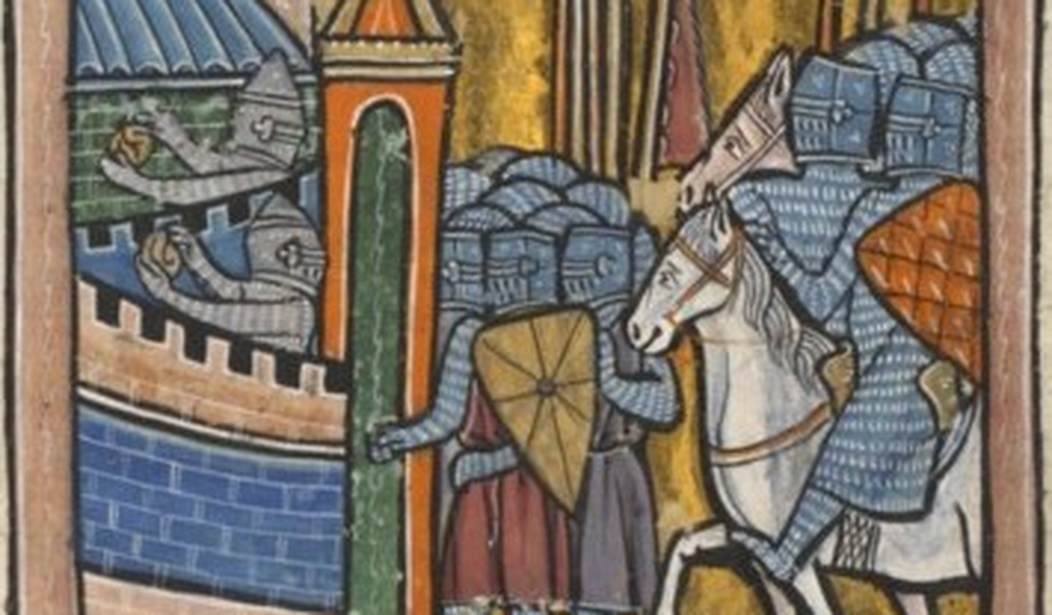Today in history, May 14, 1097, witnessed the very first clash between Western Crusaders and Muslim Turks: the siege of Nicaea.
Context: In the years following the decisive Battle of Manzikert (1071), which saw the Seljuk Turks defeat the Eastern Roman Empire and conquer that ancient bastion of Christianity, Anatolia (modern-day Turkey), mindboggling atrocities were committed. Whether an anonymous Georgian chronicler tells of how “holy churches served as stables for their horses,” the “priests were immolated during the Holy Communion itself,” the “virgins defiled, the youths circumcised, and the infants taken away,” or whether Anna Comnena, the princess at Constantinople, tells of how “cities were obliterated, lands were plundered, and the whole of Anatolia was stained with Christian blood”—the same scandalous tale of woe reached the West.
As a result, what came to be known as history’s First Crusade was launched. Paraphrasing Pope Urban II’s famous call at Clermont in 1095, Crusades historian Thomas Madden writes, “The message was clear: Christ was crucified again in the persecution of his faithful and the defilement of his sanctuaries.” Both needed rescuing; both offered an opportunity to fulfill one of Christ’s two greatest commandments: “Love God with all your heart,” and “love your neighbor as yourself” (Luke 10:27).
Christians from all around Europe hearkened to the call and took the cross. By 1097, the major lords and knights had reached Constantinople, whence they were ferried into the lion’s den, Turkic-controlled Asia Minor. By May they reached Nicaea, site of Christendom’s first ecumenical council (325), where the Nicaean Creed, which is still professed by all major Christian denominations, was articulated. Now the capital of the Seljuk sultanate and occupied by the “enemies of the cross,” the Crusaders quickly laid siege to Nicaea, 924 years ago on this date, May 14.
It was long and brutal, but the Turks held their own; from their high walls, the Muslims “shouted their war-like battle-cry in the horrible tones of their language”—the contemporary chronicler, Albert of Aachen, could not decipher the shrill cries of “Allahu Akbar!”—and “fired poisoned arrows so that even those lightly wounded met a horrible death.” Moreover, in order to defend their walls from being “struck and shaken repeatedly by the battering ram, the Turks created a combustible mixture and poured it over the walls, which torched the battering ram.” Smoke and fire rose as the siege went on.
On May 20, Kilij Arslan, the Seljuk sultan and supreme head of the Turks, appeared with a massive Muslim army to deliver Nicaea, his capital. A wild battle ensued. Albert continues:
Duke Godfrey and Bohemond did not curb their horses but let them have their heads and flew in the midst of the enemy, piercing some with lances, unsaddling others, and all the while urging on their allies, encouraging them with manly exhortations to slaughter the enemy. There was no small clash of spears there, no small rings of swords and helmets heard in this conflict of the war, no small destruction of Turks.
But it was the greater force of the crusader army under the command of Raymond of Toulouse with aid from Robert of Flanders that gave the Muslim army its death-stroke, routing them.
In this, the inaugural battle of the First Crusade,
The Arabs, Persians, and ferocious Turks soon fled; the savage people showed their backs to the Christians. It was a rout… Prodigious was the slaughter of the fleeing army…. From the third until the ninth hour the destruction, or rather Arabian slaughter, of this battle raged.
This triumphant description is not so much invention and bias on the part of Guibert of Nogent as it is a reflection of the fact that this vast Muslim army was not made of professional soldiers but largely consisted of “peasants, scum herded together from everywhere.” Later Turkish armies would be more formidable.
Having slaughtered countless Muslims, the bloodstained Westerners resumed the siege of Nicaea. As a stark and material reminder to its inhabitants not to hope for deliverance from their coreligionists, the Crusaders “lobbed the severed heads of the slaughtered Turks from their throwing-machines and catapults into the city,” writes Robert the Monk.
There was, of course, a reason that the Crusaders behaved so ruthlessly. Earlier, on first landing in Anatolia, they encountered a horrific sight: “Oh, how many severed heads and bones of the dead lying on the plains did we then find beyond Nicomedia near the sea!” wrote Fulcher of Chartres. “Moved to compassion by this, we shed many tears there.” They had come upon the remains of all those European peasants—men, women, and children—that were too impatient to wait for the professional knights at Constantinople and crossed into Asia alone. Soon after landing in the Nicaean inland in 1096, they “fell into the Turkish ambuscade and were miserably slaughtered,” recollected Princess Anna Comnena:
So great a multitude of Kelts and Normans died by the Ishmaelite sword that when they gathered the remains of the fallen, lying on every side, they heaped up, I will not say a mighty ridge or hill or peak, but a mountain of considerable height and depth and width, so huge was the mass of bones.
Those captured underwent another trial: “Some of the prisoners were challenged about their faith, and ordered to renounce Christ, but they proclaimed Christ with steady heart and voice, and were decapitated,” writes Guibert. The fate of those kept alive—as usual, the young and comely—was often worse:
The Turks divided up among themselves some of the captives, whose lives they had spared—or rather reserved for a more painful death—and submitted them to dismal servitude at the hands of cruel masters. Some were exposed in public, like targets, and were pierced by arrows; others were given away as gifts, while others were sold outright . . . [and taken to Khorasan and Antioch where] they would endure wretched slavery under the worst masters imaginable. They underwent a torture much longer than that endured by those whose heads were severed swiftly by the sword.
How the Islamic lords of Asia Minor must have laughed then! Having annihilated the indigenous Christian population of Anatolia, now European Christians were marching in for the same exact treatment.
But they were not laughing now. Along with the many Muslim heads the Crusaders had lobbed into Nicaea, another “one thousand of these heads were sent to the emperor, a present which won his hearty favor”—unsurprisingly so, as these were the same men who had sacked and taken Nicaea from Emperor Alexios in 1092. He responded by sending more supplies, including much-needed boats for the Crusaders to cut off Nicaea’s only supply route. These the Crusaders, “during the course of one night, by ropes placed on the shoulders and necks of men and horses,” dragged to Nicaea, “a distance of seven miles or more,” says William of Tyre.
Soon thereafter, on June 19, 1097, the now overly traumatized Turks—these longtime scourges of Eastern Christendom—surrendered Nicaea, on condition that they capitulate, not to the heavily armored newcomers from the West who had so terrorized them, but to Alexios, who had followed the Crusaders with his own army.
And so, the First Crusade began with a victory over the Muslims, just as it would conclude. But that is another story.










Join the conversation as a VIP Member